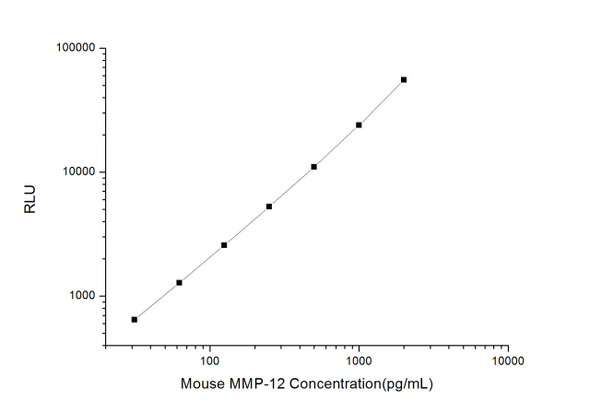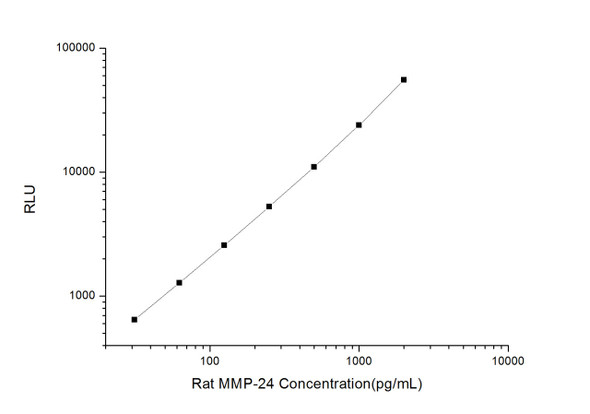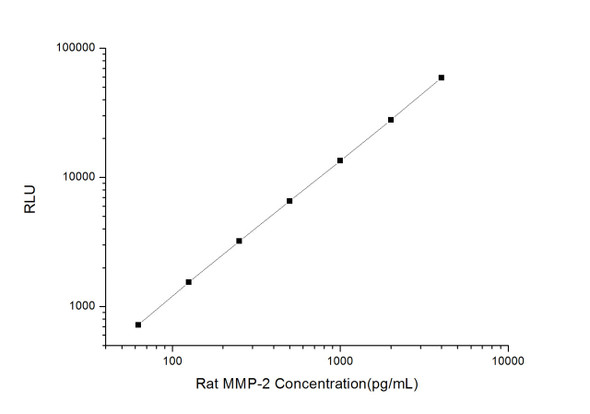Rat Signaling ELISA Kits 2
Rat MMP-12 (Matrix Metalloproteinase 12) CLIA Kit (RTES00026)
- SKU:
- RTES00026
- Product Type:
- ELISA Kit
- ELISA Type:
- CLIA Kit
- Size:
- 96 Assays
- Sensitivity:
- 9.38pg/mL
- Range:
- 15.63-1000pg/mL
- ELISA Type:
- Sandwich
- Synonyms:
- MMP12, HME, ME, MME, Macrophage Metalloelastase, Macrophage Elastase
- Reactivity:
- Rat
- Sample Type:
- Serum, plasma and other biological fluids
Description
| Assay type: | Sandwich |
| Format: | 96T |
| Assay time: | 4.5h |
| Reactivity: | Rat |
| Detection method: | Chemiluminescence |
| Detection range: | 15.63-1000 pg/mL |
| Sensitivity: | 9.38 pg/mL |
| Sample volume: | 100µL |
| Sample type: | Serum, plasma and other biological fluids |
| Repeatability: | CV < 15% |
| Specificity: | This kit recognizes Rat MMP-12 in samples. No significant cross-reactivity or interference between Rat MMP-12 and analogues was observed. |
This kit uses Sandwich-CLIA as the method. The micro CLIA plate provided in this kit has been pre-coated with an antibody specific to Rat MMP-12. Standards or samples are added to the appropriate micro CLIA plate wells and combined with the specific antibody. Then a biotinylated detection antibody specific for Rat MMP-12 and Avidin-Horseradish Peroxidase (HRP) conjugate are added to each micro plate well successively and incubated. Free components are washed away. The substrate solution is added to each well. Only those wells that contain Rat MMP-12, biotinylated detection antibody and Avidin-HRP conjugate will appear fluorescence. The Relative light unit (RLU) value is measured spectrophotometrically by the Chemiluminescence immunoassay analyzer. The RLU value is positively associated with the concentration of Rat MMP-12. The concentration of Rat MMP-12 in the samples can be calculated by comparing the RLU of the samples to the standard curve.
| UniProt Protein Function: | Function: May be involved in tissue injury and remodeling. Has significant elastolytic activity. Can accept large and small amino acids at the P1' site, but has a preference for leucine. Aromatic or hydrophobic residues are preferred at the P1 site, with small hydrophobic residues (preferably alanine) occupying P3 |
| UniProt Protein Details: | By similarity. Catalytic activity: Hydrolysis of soluble and insoluble elastin. Specific cleavages are also produced at 14-Ala-|-Leu-15 and 16-Tyr-|-Leu-17 in the B chain of insulin. Cofactor: Binds 4 calcium ions per subunit By similarity. Binds 2 zinc ions per subunit By similarity. Subcellular location: Secreted extracellular space extracellular matrix By similarity. Domain: The conserved cysteine present in the cysteine-switch motif binds the catalytic zinc ion, thus inhibiting the enzyme. The dissociation of the cysteine from the zinc ion upon the activation-peptide release activates the enzyme. Sequence similarities: Belongs to the peptidase M10A family. Contains 4 hemopexin repeats. |
| NCBI Summary: | a macrophage metalloelastase/matrix metalloproteinase; may have a role in glomerular injury in a crescentic glomerulonephritis [RGD, Feb 2006] |
| UniProt Code: | Q63341 |
| NCBI GenInfo Identifier: | 291327537 |
| NCBI Gene ID: | 117033 |
| NCBI Accession: | NP_446415. 2 |
| UniProt Secondary Accession: | Q63341,Q5I0P0, |
| UniProt Related Accession: | Q63341 |
| Molecular Weight: | 22. 8kDa |
| NCBI Full Name: | macrophage metalloelastase preproprotein |
| NCBI Synonym Full Names: | matrix metallopeptidase 12 |
| NCBI Official Symbol: | Mmp12 |
| NCBI Official Synonym Symbols: | Mme |
| NCBI Protein Information: | macrophage metalloelastase; MMP-12; matrix metalloproteinase 12; matrix metalloproteinase-12 |
| UniProt Protein Name: | Macrophage metalloelastase |
| UniProt Synonym Protein Names: | Matrix metalloproteinase-12 |
| Protein Family: | Macrophage metalloelastase |
| UniProt Gene Name: | Mmp12 |
| UniProt Entry Name: | MMP12_RAT |
As the RLU values of the standard curve may vary according to the conditions of the actual assay performance (e. g. operator, pipetting technique, washing technique or temperature effects), the operator should establish a standard curve for each test. Typical standard curve and data is provided below for reference only.
| Concentration (pg/mL) | RLU | Average | Corrected |
| 1000 | 49995 57355 | 53675 | 53650 |
| 500 | 22203 22775 | 22489 | 22464 |
| 250 | 10470 9952 | 10211 | 10186 |
| 125 | 4666 5136 | 4901 | 4876 |
| 62.5 | 2463 2443 | 2453 | 2428 |
| 31.25 | 1338 1224 | 1281 | 1256 |
| 15.63 | 705 711 | 708 | 683 |
| 0 | 24 26 | 25 | -- |
Precision
Intra-assay Precision (Precision within an assay): 3 samples with low, mid range and high level Rat MMP-12 were tested 20 times on one plate, respectively.
Inter-assay Precision (Precision between assays): 3 samples with low, mid range and high level Rat MMP-12 were tested on 3 different plates, 20 replicates in each plate.
| Intra-assay Precision | Inter-assay Precision | |||||
| Sample | 1 | 2 | 3 | 1 | 2 | 3 |
| n | 20 | 20 | 20 | 20 | 20 | 20 |
| Mean (pg/mL) | 52.03 | 116.65 | 411.82 | 47.83 | 125.05 | 437.47 |
| Standard deviation | 6.56 | 11.83 | 46.49 | 4.11 | 8.89 | 32.46 |
| C V (%) | 12.61 | 10.14 | 11.29 | 8.59 | 7.11 | 7.42 |
Recovery
The recovery of Rat MMP-12 spiked at three different levels in samples throughout the range of the assay was evaluated in various matrices.
| Sample Type | Range (%) | Average Recovery (%) |
| Serum (n=5) | 98-117 | 106 |
| EDTA plasma (n=5) | 102-115 | 107 |
| Cell culture media (n=5) | 88-101 | 95 |
Linearity
Samples were spiked with high concentrations of Rat MMP-12 and diluted with Reference Standard & Sample Diluent to produce samples with values within the range of the assay.
| Serum (n=5) | EDTA plasma (n=5) | Cell culture media (n=5) | ||
| 1:2 | Range (%) | 101-116 | 95-110 | 91-106 |
| Average (%) | 109 | 102 | 98 | |
| 1:4 | Range (%) | 88-103 | 96-111 | 97-112 |
| Average (%) | 94 | 104 | 103 | |
| 1:8 | Range (%) | 94-108 | 99-112 | 95-107 |
| Average (%) | 100 | 105 | 102 | |
| 1:16 | Range (%) | 87-98 | 90-101 | 92-109 |
| Average (%) | 93 | 96 | 99 |
An unopened kit can be stored at 4°C for 1 month. If the kit is not used within 1 month, store the items separately according to the following conditions once the kit is received.
| Item | Specifications | Storage |
| Micro CLIA Plate(Dismountable) | 8 wells ×12 strips | -20°C, 6 months |
| Reference Standard | 2 vials | |
| Concentrated Biotinylated Detection Ab (100×) | 1 vial, 120 µL | |
| Concentrated HRP Conjugate (100×) | 1 vial, 120 µL | -20°C(shading light), 6 months |
| Reference Standard & Sample Diluent | 1 vial, 20 mL | 4°C, 6 months |
| Biotinylated Detection Ab Diluent | 1 vial, 14 mL | |
| HRP Conjugate Diluent | 1 vial, 14 mL | |
| Concentrated Wash Buffer (25×) | 1 vial, 30 mL | |
| Substrate Reagent A | 1 vial, 5 mL | 4°C (shading light) |
| Substrate Reagent B | 1 vial, 5 mL | 4°C (shading light) |
| Plate Sealer | 5 pieces | |
| Product Description | 1 copy | |
| Certificate of Analysis | 1 copy |
- Set standard, test sample and control (zero) wells on the pre-coated plate and record theirpositions. It is recommended to measure each standard and sample in duplicate. Note: addall solutions to the bottom of the plate wells while avoiding contact with the well walls. Ensuresolutions do not foam when adding to the wells.
- Aliquot 100µl of standard solutions into the standard wells.
- Add 100µl of Sample / Standard dilution buffer into the control (zero) well.
- Add 100µl of properly diluted sample (serum, plasma, tissue homogenates and otherbiological fluids. ) into test sample wells.
- Cover the plate with the sealer provided in the kit and incubate for 90 min at 37°C.
- Aspirate the liquid from each well, do not wash. Immediately add 100µL of BiotinylatedDetection Ab working solution to each well. Cover the plate with a plate seal and gently mix. Incubate for 1 hour at 37°C.
- Aspirate or decant the solution from the plate and add 350µL of wash buffer to each welland incubate for 1-2 minutes at room temperature. Aspirate the solution from each well andclap the plate on absorbent filter paper to dry. Repeat this process 3 times. Note: a microplatewasher can be used in this step and other wash steps.
- Add 100µL of HRP Conjugate working solution to each well. Cover with a plate seal andincubate for 30 min at 37°C.
- Aspirate or decant the solution from each well. Repeat the wash process for five times asconducted in step 7.
- Add 100µL of Substrate mixture solution to each well. Cover with a new plate seal andincubate for no more than 5 min at 37°C. Protect the plate from light.
- Determine the RLU value of each well immediately.






